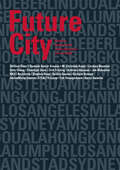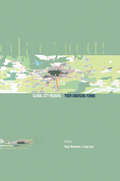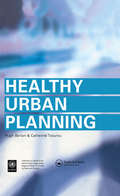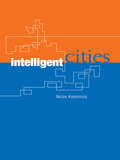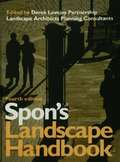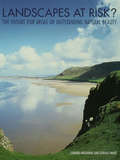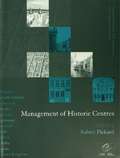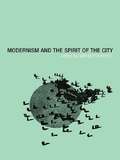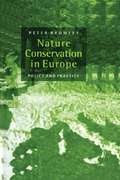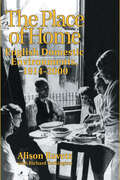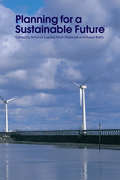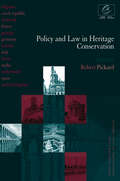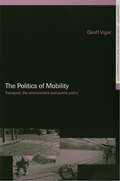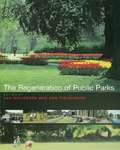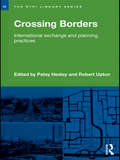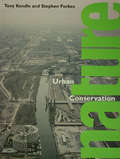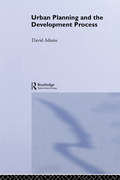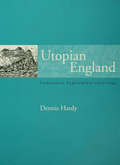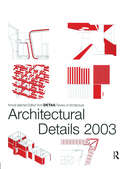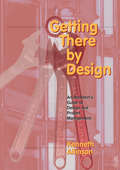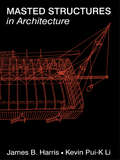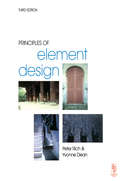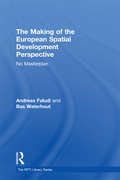- Table View
- List View
Future City
by Stephen Read Jürgen Job Van EldijkThis text focuses on cities as the dominant form of human settlement for the future, examining the transformation that is happening in urban connobations worldwide today. The last few decades have seen a rate of change and growth in cities that has never been seen before, resulting in giant metropoles with over twenty million inhabitants. This book tackles the causes of these changes, and looks at how the planning and design of cities can shape the urban future.
Global City Regions: Their Emerging Forms
by Roger Simmonds Gary HackA unique comparative study based on funded research, of eleven city regions across three continents looking at changes over the last 30 years. Detailed changes in land use are presented here with series of maps prepared especially for the study. The socio-economic and physical forms of city regions have been examined for comparative study and the findings will be of interest to all those concerned with urban development in their professional and academic work. The book features numerous maps which underline research findings. Cities covered are: Ankara, Bangkok, Boston, Madrid, Randstad, San Diego, Chile, Sao Paulo, Seattle and the Central Puget, Taipei, Tokyo, West Midlands.
Healthy Urban Planning
by Hugh Barton Catherine TsourouHealthy Urban Planning aims to refocus urban planners on the implications of their work for human health and well-being. If many of the problems faced in cities are to be resolved, improving health will be the fundamental goal of urban planners. Poor housing, poverty, stress, pollution, and lack of access to jobs, goods and services all impact upon health. This book provides practical advice on ways to integrate health and urban planning and will be essential reading for urban planners, developers, urban designers, transport planners, and those working in the fields of regeneration and renewal. It will also be of interest to those with an interest in sustainable development.
Intelligent Cities: Innovation, Knowledge Systems and Digital Spaces (Regions And Cities Ser.)
by Nicos KomninosAt the turn of the century some cities and regions in Europe, Japan and the USA, displayed an exceptional capacity to incubate and develop new knowledge and innovations. The favourable environment for research, technology and innovation created in these areas was not immediately obvious, yet it was of great significance for a development based on knowledge, learning, and innovation. Intelligent Cities focuses on these environments of innovation, and the major models (technopoles, innovating regions, intelligent cities) for creating an environment-supporting technology, innovation, learning, and knowledge-based development.The introduction and the first chapter deal with innovation as an environmental condition, and with the geography and typology of islands of innovation. The next three parts focus on the theoretical paradigms and the planning models of the 'industrial district', the innovating region', and the 'intelligent city', which offer three alternative ways to create an environment of innovation.
Spon's Landscape Handbook
by Derek Lovejoy PartnershipThere have been such great changes in legislation, official guidance, the British Standards and the techniques used in landscape and external works since the third edition was written ten years ago that the Handbook has been totally rewritten for this edition.This new edition of the Handbook provides a guide to planning and landscape law, a review of computer-aided design techniques for landscape designers, together with guidance on data to be collected during first site visits. The opportunity has been taken to change the format of the work sections to comply with SMM7 to make it easier to find specific items and to read in conjunction with the current edition of Spon's Landscape and External Works Price Book. The SMM7 sections are now divided into four parts - General Guidance, British Standards, Data and Outline Specification. Diagrams, typical drawings and photographs illustrate each section. The useful bibliography has been updated and revised.
Landscapes at Risk?: The Future for Areas of Outstanding Natural Beauty in England and Wales
by Edward Holdaway Gerald SmartAreas of Outstanding Natural Beauty (AONBs) together with National Parks are the highest quality landscapes in England and Wales, and have been designated to conserve that quality. AONBs have always been regarded as 'second' to national parks in terms of the legislation and resources provided by the nation to look after them. At the turn of the century they are at a cross-roads - there are many challenges to be overcome if they are to survive as the best. This book examines whether they are fit to meet the challenges and sets out a bold new Agenda for their survival.Landscapes at Risk? covers the history and development of AONBs in England and Wales set in the context of protected landscapes generally in the UK. It focuses on the evolution of policies towards them, the arrangements for their administration, conservation and management, the land management and planning context within which they have evolved, and the adequacy of the proposals that have been put forward for their long-term well-being. Throughout the analysis there are numerous references to the many initiatives that have been and are being taken by AONB managers and others to secure their future. The book features a series of case studies of individual AONBs to illustrate the main points being made in the text.
Management of Historic Centres (Conservation Of The European Built Heritage Ser.)
by Robert PickardThis book examines key themes for the management of historic urban centres within a representative sample of centres in different European countries. The twelve historic centres that have been chosen are spread throughout Europe. They are diverse in character and the range includes small towns, cities and urban centres within cities. Some have been designated by UNESCO as World Heritage Sites or Cities, whilst others have recognition, or have been proposed as European Cities of Culture. The centres have all faced different problems and a variety of approaches have been utilised which are also examined. For each of the historic centres in the book the authors broadly cover a number of common themes: the policy and planning framework; management and regeneration action; environmental management; tourism and heritage management; and sustainability.
Modernism and the Spirit of the City
by Iain Boyd WhyteModernism and the Spirit of the City offers a new reading of the architectural modernism that emerged and flourished in Europe in the first half of the twentieth century. Rejecting the fashionable postmodernist arguments of the 1980s and '90s which damned modernist architecture as banal and monotonous, this collection of essays by eminent scholars investigates the complex cultural, social, and religious imperatives that lay below the smooth, white surfaces of new architecture.
Nature Conservation in Europe: Policy and Practice
by Peter BromleyThe Rio Summit has pointed to the urgency for the development of an international conservation policy; and the post-Maastricht debates in Europe have highlighted the need for the EU to reassess structural funding in nature conservation, as well as the influences on policy and practice.This book is a 'route map' through the legislative and policy frameworks and explains how conservation works in Europe. It goes through the policies for nature conservation in the European Community and its constituent member states and sets out the mechanisms for delivering this policy.An understanding of the European legislative framework is now vital as its influence on local practice increases. Practitioners in the fields of countryside conservation and general land management will find the book an essential guide to the working of the EU, as well as helping an appreciation of their local role within the wider community objectives. This will, for example allow a better understanding of the grant system which many managers are now using.
The Place of Home: English domestic environments, 1914-2000 (Planning, History and Environment Series)
by Alison Ravetz Professor Alison Ravetz R. TurkingtonA comprehensive and in-depth history of the 20th century English home, how it has been created, and how it works for people. It focuses on the various influences bearing on the development of domestic space since 1914 and covers both design and housing policy. Current debates from participation to co-operative housing are examined and several themes not previously brought together are linked, e.g. urban development/house design; technology at home/women and home; social meaning of home.
Planning for a Sustainable Future
by Antonia Layard Simin Davoudi Susan BattySustainable Development is now firmly on the planning agenda and is an issue neither practitioner nor academic can afford to ignore. Planning for a Sustainable Future provides a multi-disciplinary overview of sustainability issues in the land use context, focusing on principles and their application, the legal, political and policy context and the implication of sustainable development thinking for housing, urban design and property development as well as waste and transport. The book concludes by considering how sustainable and unsustainable impacts alike can be measured and modelled, providing real tools to move beyond rhetoric into practice.
Policy and Law in Heritage Conservation (Conservation Of The European Built Heritage Ser.)
by Robert PickardThis book has been developed in association with the Cultural Heritage Department of the Council of Europe. It examines key themes and objectives for the protection of the architectural and archaeological heritage in a range of European countries. The analysis of individual countries and the group as a whole gives an assessment of how advanced current mechanisms are and the ongoing problems that remain to be managed in order to safeguard the 'common heritage'.
The Politics of Mobility: Transport Planning, the Environment and Public Policy (Transport, Development and Sustainability Series)
by Geoff VigarTransport issues are critically embedded in everyday life. For this very reason, ways of addressing such issues are almost always hugely politically contentious, as a quick glance at local and national media will testify. Such contentiousness is growing as ever increasing mobility for many in western society has led to a critical examination of the fundamental basis by which transport issues are considered in government and beyond. Despite the strength of this examination, the implementation of new approaches to dealing with transport issues has proved deeply problematic. The Politics of Mobility pioneers a methodological and theoretical framework derived from the social and political sciences to shed light on the complexities of dealing with these issues. It mobilises three case studies that highlight the realpolitik of dealing with such concerns for students, practitioners, researchers and activists.
The Regeneration of Public Parks
by Jan Woudstra Ken FieldhouseThe Urban Parks Programme, financed by the Heritage Lottery Fund, has sparked a new enthusiasm for the regeneration of Britain's parks. This unique reference book gives a valuable overview of all the elements of public park design. It emphasizes our parks' diversity and richness, and offers practical guidance as to their renovation and future care. It is essential reading for all those involved in the design, upkeep and regeneration of public parks.
Crossing Borders: International Exchange and Planning Practices (RTPI Library Series)
by Patsy HealeyThe complex diffusion processes affecting the flow of planning ideas and practices across the globe are illustrated in this book. It raises questions about why and how some ideas and practices attract international attention, and about the invention processes which go on when external influences are woven together with local efforts to meet local specifics and requirements. Initiated to celebrate the tenth anniversary of the journal Planning Theory and Practice in 2009, this book reflects the themes of the journal. Taking different intellectual perspectives, this collection takes a critical look at the international diffusion of planning ideas and practices, their impacts on planning practices in different contexts, on the challenge of ‘situating’ planning practices, and on the ethical and methodological issues of international exchange in the planning field.
Urban Nature Conservation: Landscape Management in the Urban Countryside
by Stephen Forbes Tony KendleUrban nature conservation is a field that has grown rapidly in importance over the past 20 years and will continue to do so in the coming years as landscape ecology and greenspace planning become established disciplines. A widespread concern and interest in the wild plants and animal life found in urban areas now influences the policies and practices of land management organizations. This book provides a comprehensive overview of the subject. It will assist professionals in formulating strategic management policies that integrate urban nature conservation into the wider context of landscape management and urban planning.
Urban Planning And The Development Process
by David AdamsThis text is about the very essence of urban planning in a market economy. It is concerned with people - landowners, developers, investors, politicians and ordinary members of the public - who produce change in towns and cities as they relate to each other and react to development Pressure. Whether Such Change Occurs Slowly And Is Almost Unnoticed, Or happens rapidly and is highly disruptive, a production process is creating a finished product: the built environment. This form of production, known as the land and property development process, is regulated but not controlled by the state. Urban planning is therefore best considered as one form of state intervention in the development process.; Since urban planning would have no legitimate basis without state power, it is an inherently political activity, able to alter the distribution of scarce environmental resources. Through doing so, it seeks to resolve conflicts of interest over the use and development of land. However, urban plans that appear to favour particular interests such as house-builders above others such as community groups provoke intense controversy. Development planning can thus become highly politicized, with alliances and divisions between politicians not always explained by traditional party politics.; These issues are explored with particular reference to statutory plan-making at the local level. The author draws on his extensive research into urban planning and development, making use of recent case studies and examples to illustrate key points. There are four parts. The first explores the operation of land and property markets and development processes, and examines how the state intervenes in the form of urban planning. The second part looks at the people and organizations who play a critical role in shaping the built environment and considers their relationship with the planning system. Specific attention is paid to important actors in the development process, such as landowners, developers, financial institutions, professional advisers and to the variety of agencies in the public sector that aim to promote development. This concludes with discussion of public- private partnerships and growth coalitions. The third part of the book concentrates on local development planning.
Utopian England: Community Experiments 1900-1945 (Planning, History and Environment Series)
by Dennis HardyEngland in the early part of the twentieth century was rich in utopian ventures - diverse and intriguing in their scope and aims. Two world wars, an economic depression, and the emergence of fascist states in Europe were all a spur to idealists to seek new limits - to escape from the here and now, and to create sanctuaries for new and better lives.Dennis Hardy explores this fascinating history of utopian ideals, the lives of those who pursued them, and the utopian communities they created.Some communities were fired by a long tradition of land movements, others by thoughts of more humane ways of building towns. In turn there were experiments devoted to the arts; to the promotion of religious doctrine; and to a variety of political causes. And some were just 'places of the imagination'.Utopian England is about just one episode in the perennial search for perfection, but what is revealed has lessons that extend well beyond a particular time and place. So long as there are failings in society, so long as rationality is not enough, there will continue to be a place for thinking the impossible, for going in search of utopia.
Nurseries: A Design Guide
by Mark DudekArchitecture can inspire young children; the very shape and form of a daycare center can not only stimulate their imagination but can help children form strong relationships and help promote development. This design guide presents all the elements of building design that combine to create the very best environment for young children and the people who work with them, including building materials, multi-functional spaces and design scaled to suit small children.
Architectural Details 2003
by Detail MagazineThis is a compilation of the full year's information, including: the "Discussion" section, where well-known architects and critics as well as specialist authors and architectural historians articulate their views; the "Documentation" section containing an analysis of selected projects, in which buildings from around the world are covered in depth; and the "Technology" section where the specific theme of each issue of the magazine is treated in greater depth. Along with these are illustrations of the high standards that Detail is known for, where all plan drawings are true to scale and have been approved by the architects, planners and engineers responsible for the original design.This annual sourcebook is a beautiful record, not only of the year's Detail publication, but of some of the best, and most innovative contemporary architecture
Getting There by Design
by Kenneth AllinsonThere was military project management. There was construction project management. Then there was business project management, a tool described as 'the wave of the future'. Where are architects in all this, professionals whose work has always been project-driven? There is design management in engineering, product design, graphics, packaging, management theory and even in politics. Construction consultants talk about managing design. When are architects going to become committed to managing design?Getting There by Design adopts an architect's view to design and project management. It sets out the fundamental principles and shows how they are applied, dealing with these two topics as one indivisible subject.'Getting There by Design' demonstrates how to: - make project efforts goal-oriented - set up a planning and monitoring basis to architectural projects - put the architect's fee calculus on a rationale basis - diagnose your firm's practice culture - develop successful teamsPut your practice onto a more effective basis.Ken Allinson is an architect in private practice and principal of 'Architectural Dialogue'. He also teaches design studio and lectures on design and project management. He was formerly an associate at DEGW London and the Terry Farrell Partnership. He has practice experience in Europe, the USA and Japan and is the author of 'The Wild Card of Design' (1993).
Tony Hunt's Second Sketchbook
by Tony Hunt Sir Norman FosterTony Hunt's Sketchbook illustrates the connection between brain and hand in conceiving structural concepts and details as possible solutions to structures in architecture. This new edition features 100 previously unpublished sketches. These sketches illustrate alternative structural concepts, ideas and details developed by Tony Hunt for over one hundred projects throughout his professional life. They relate directly to projects built and unbuilt in the field of structural engineering and were either produced at the time of relevant design meetings or as a response to a problem posed by an architect and are, therefore, a record of ideas proposed at the particular time. They are a source of design inspiration and an insight into the work of this well respected engineer.
Masted Structures in Architecture
by James Harris Kevin LiThis is the first fully comprehensive survey and analysis of masted structures and covers examples that have evolved during the past three decades.Masted Structures are one of the most interesting developments in post-war architecture resulting from a combination of technology, structural engineering theory and a collaboration between architects and engineers. This is an essential guide for architects to the structural and constructional implications of masted forms in relation to space enclosure, patterns of loading and use of differing materials and techniques. This useful volume will enable architects and engineers to understand the origins, development and nature of masted structures and will provide a stimulating basis for future design.
Principles of Element Design
by Yvonne Dean Peter RichThe construction of buildings is learnt through experience and the inheritance of a tradition in forming buildings over several thousand years. Successful construction learns from this experience which becomes embodied in principles of application. Though materials and techniques change, various elements have to perform the same function. 'Principles of Element Design' identifies all the relevant elements and then breaks these elements down into all their basic constituents, making it possible for students to fully understand the given theory and principles behind each part. As all building projects are subject to guidance through the Building Regulations and British Standards, this book gives an immediate reference back to relevant information to help practitioners and contractors identify key documents needed.Yvonne Dean B.A. (Hons) B.A (Open) RIBA, an architect, energy consultant and materials technologist. She also has 15 years experience as a lecturer, travels widely and is a guest lecturer at many universities. She pioneered an access course for Women into Architecture and Building, which has been used as a template by others, and has been instrumental in helping to change the teaching of technology for architects and designers.Peter Rich AA Dipl. (Hons) Architect, started his career with 14 years experience as a qualified architectural technician. He then joined the AA School of Architecture, working with Bill Allen and John Bickerdike after his graduation, later becoming a partner of Bickerdike Allen Rich and Partners. He also taught building construction at the Bartlett School of Architecture, University College London, and architectural design at the Polytechnic of North London. He now acts as a Consultant.
The Making of the European Spatial Development Perspective: No Masterplan (RTPI Library Series)
by Andreas Faludi Bas WaterhoutThe European Spatial Development Perspective (ESDP) is published in eleven official EU languages and so is the most international planning policy document that exists. This book is the only comprehensive account of the process of preparing, negotiating and adopting this document. It outlines the differing perspectives of the European member states and shows that the last thing its proponents wanted is a masterplan. The Making of the European Spatial Development Perspective is a unique book offering a snapshot of contemporary European spatial planning.
